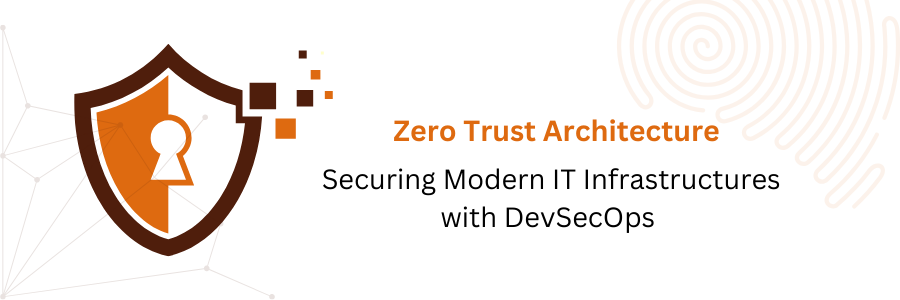Zero Trust Architecture: Securing Modern IT Infrastructures with DevSecOps

In an increasingly interconnected and dynamic digital landscape, traditional security models are proving insufficient in safeguarding against sophisticated cyber threats. Enter Zero Trust Architecture (ZTA), a paradigm-shifting approach to cybersecurity that challenges the conventional notion of trust and perimeter-based security. As organizations strive to fortify their defenses and protect sensitive assets, the adoption of Zero Trust principles has emerged as a strategic imperative. In this blog post, we'll delve into the rising importance of Zero Trust Architecture in securing modern IT infrastructures and explore how DevSecOps practices align with this transformative approach.
Redefining Trust in a Perimeter-less World
Traditionally, security architectures relied on the concept of a trusted internal network protected by perimeter defenses. However, with the proliferation of cloud services, remote work, and interconnected ecosystems, the perimeter has become increasingly porous, rendering traditional security models ineffective. Zero Trust Architecture operates on the fundamental principle of "never trust, always verify," asserting that trust should not be automatically granted based on location or network position. Instead, every user, device, and application must be continuously authenticated and authorized, regardless of their location or context.
The Pillars of Zero Trust
Zero Trust Architecture is built upon several core principles, including:
Least Privilege Access: Grant users and devices only the minimum level of access required to perform their tasks, reducing the attack surface and limiting the potential impact of security breaches.
Microsegmentation: Divide the network into smaller, isolated segments to contain lateral movement and limit the spread of threats in the event of a breach.
Continuous Authentication: Implement continuous authentication mechanisms, such as multi-factor authentication (MFA) and behavioral analytics, to verify the identity and trustworthiness of users and devices throughout their interactions with the network.
Encryption Everywhere: Encrypt data both in transit and at rest to protect sensitive information from unauthorized access and interception.
Aligning DevSecOps with Zero Trust
DevSecOps, an extension of DevOps principles, emphasizes the integration of security into every stage of the software development lifecycle. While traditionally focused on accelerating delivery and improving collaboration between development and operations teams, DevSecOps is inherently aligned with the principles of Zero Trust Architecture. Here's how:
Shift-Left Security: DevSecOps promotes the early integration of security into the development process, aligning with the Zero Trust principle of continuous verification. By incorporating security controls and automated testing into CI/CD pipelines, organizations can identify and remediate vulnerabilities before they propagate to production environments.
Immutable Infrastructure: DevSecOps encourages the use of immutable infrastructure patterns, where components are immutable and replaced rather than modified. This approach aligns with Zero Trust principles by reducing the attack surface and limiting the persistence of potential threats.
Continuous Monitoring and Response: DevSecOps emphasizes continuous monitoring of applications and infrastructure, enabling organizations to detect and respond to security incidents in real-time. By leveraging security analytics and threat intelligence feeds, DevSecOps teams can enhance their visibility and proactively mitigate security risks, aligning with the Zero Trust principle of continuous authentication and authorization.
In an era defined by pervasive cyber threats and evolving attack vectors, Zero Trust Architecture has emerged as a foundational strategy for securing modern IT infrastructures. By challenging the traditional notions of trust and perimeter-based security, Zero Trust Architecture provides a proactive and adaptive approach to cybersecurity, aligning with the core tenets of DevSecOps. By integrating security into every aspect of the software development lifecycle and embracing Zero Trust principles, organizations can fortify their defenses, protect sensitive assets, and thrive in an increasingly interconnected world.


